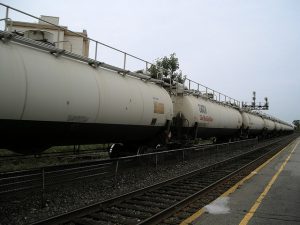One of the first oil pipelines originated in the 1860s, when the Oil Transport Association constructed a wrought iron pipeline from an oil field in Pennsylvania to a railroad station 6 miles away. The pipeline was only 2 inches in diameter. Pipelines are generally more economical than shipping by railroad. But they have more regulatory hurdles. With the recent problems with getting approval for the Keystone XL pipeline, rail transportation has been growing.
Pipeline Facts:
The oil is kept in motion by pump stations along the pipeline and usually flows at speed of about 1 to 6 metres per second (3.3 to 20 ft/s). Crude oil contains varying amounts of wax or paraffin, and in colder climates wax buildup may occur within a pipeline. Often these pipelines are inspected and cleaned using “pigs” also known as scrapers or Go-devils. They are launched from pig-launcher stations and travel through the pipeline to be received at another station down-stream, either cleaning wax deposits and material that may have accumulated inside the line or inspecting and recording the condition of the line. “Smart pigs” can detect anomalies in the pipe such as dents, metal loss caused by corrosion, cracking or other mechanical damage. Source: Wikipedia- Oil PipelinesOil Pipelines vs Rail
The Association of American Railroads reports the number of rail tankers carrying crude oil and petroleum products in the United States increased more than 35 percent during the first six months of the year when compared with 2011. After the U.S. Energy Department, in its report, noted the lack of pipeline infrastructure in North Dakota, British supermajor BP announced it was considering rail to bring oil from the Bakken formation there to its refinery in Washington state. In terms of the environmental footprint, meanwhile, rail deliveries account for less than 1 percent of the total emissions from the transportation sector. These findings come even though rail shipments are three times more expensive than pipeline deliveries.

Rail deliveries, however, cost, on average, $15 per barrel compared with the $5 per barrel for deliveries through pipeline systems. On the other hand, the rail system is getting less energy-intensive. While the transportation sector accounts for about 25 percent of the global energy-related carbon dioxide emissions, rail represents a minor fraction of that total. Across the board, emissions for transportation are increasing in every sector except rail, which accounts for less than 1 percent of total CO2 emissions for the sector.
When completed, the entire Keystone oil pipeline network could carry about 1.1 million BPD compared with the same approximate total for the entire United States for rail. The 3,100-mile Enbridge Pipeline System, which stretches from the Athabasca oil sands facilities in Alberta to oil refineries in the Midwest, can carry, on average, 1.4 million BPD. The week before last, however, more than 1,000 barrels oil spilled from a section of that pipeline in Wisconsin. While Enbridge said much of the release was contained, the incident occurred one day after the two-year anniversary of the costliest onshore crude oil spill in U.S. history from a section of the same pipeline network. Though in terms of volume, pipeline transportation has proved its merit, the move by BP in the Bakken formation suggests rail transit remains a viable option for the industry.
See Also:
- Oil Prices- Where Now?
- Things Are About to Get Much Worse for Energy Firms in Argentina
- Investing in Oil for Small Investors
- How is the Keystone XL Pipeline Progressing?
- Iran Finds Oil in Caspian
- Oil Prices < $40/Barrel?
- InflationData: Historical Oil Prices Chart
- Historical Oil Prices in Table
- Gold vs Oil Chart
- Gasoline vs. Oil Price Chart
- Oil, Investment and a Turkish Gamble
Source: http://oilprice.com/Energy/Energy-General/Rail-May-Hold-its-Own-Against-Pipelines.html
About the Author:
Daniel Graeber of Oilprice.com

